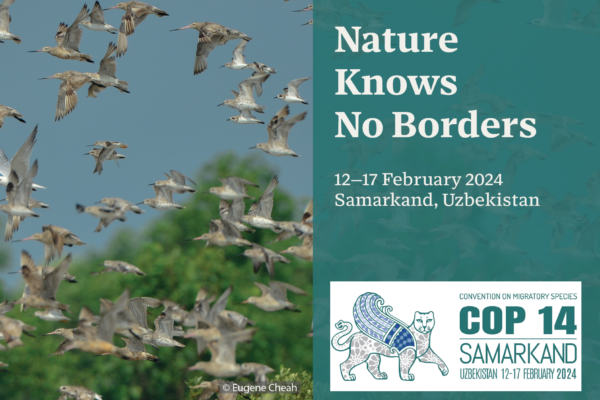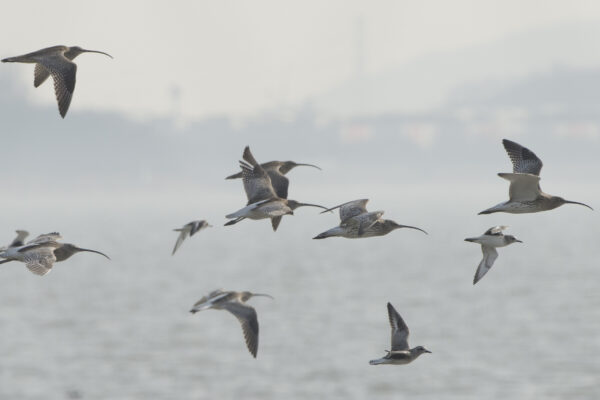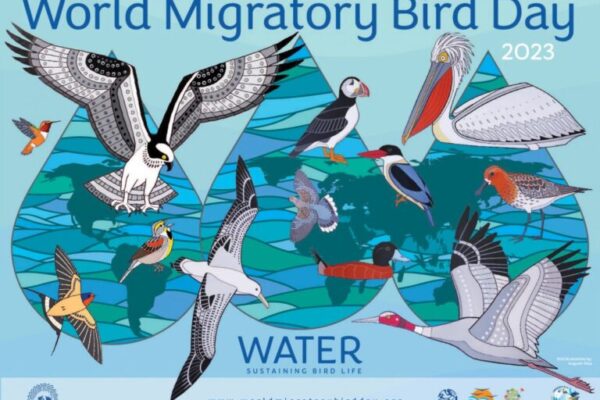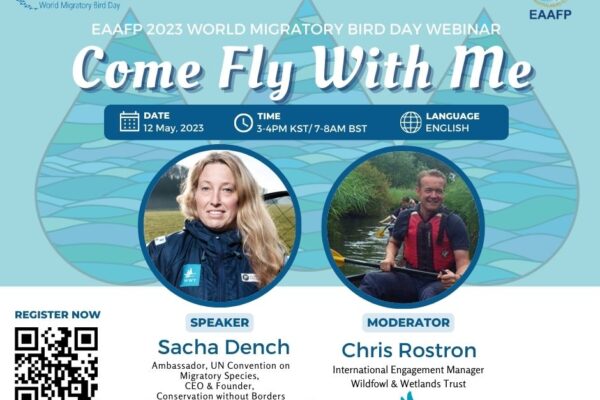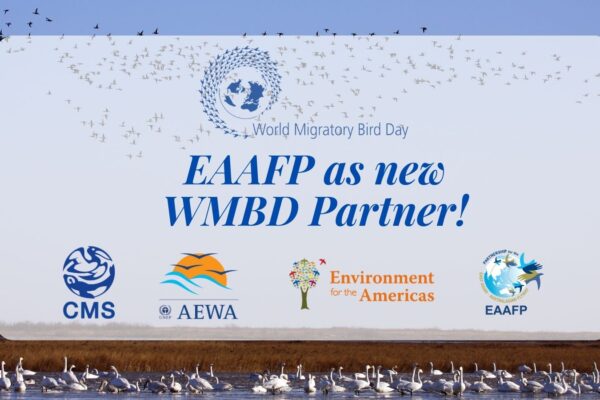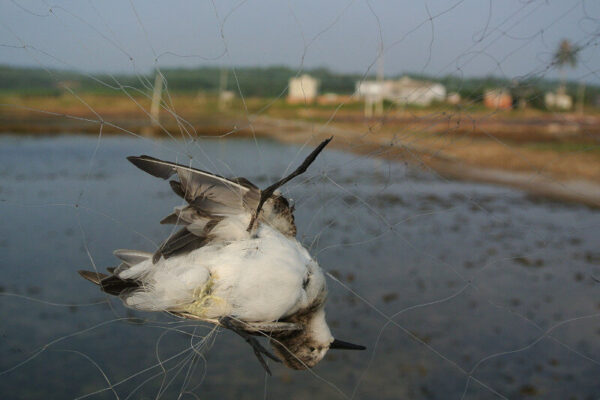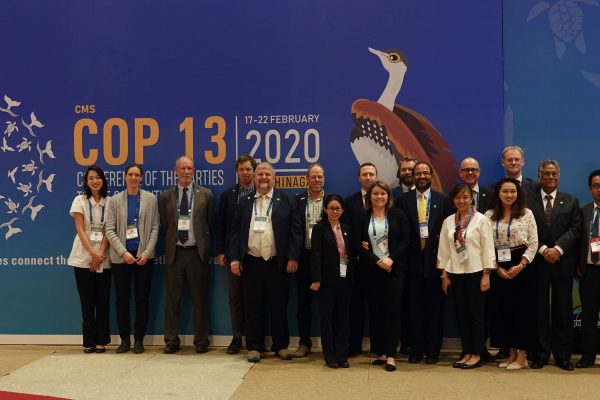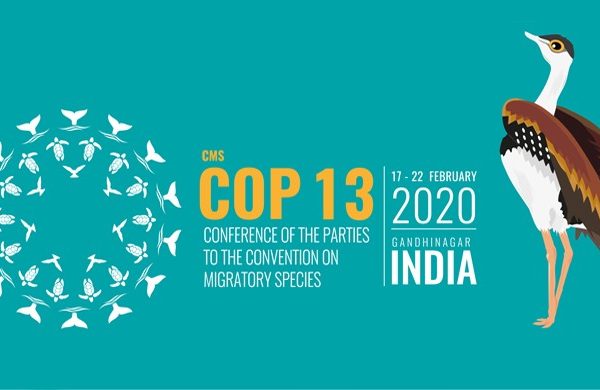-
EAAFP at CMS COP14: Nature Knows No Borders
The Convention on the Conservation of Migratory Species of Wild Animals (CMS) has stood steadfast as a pivotal intergovernmental partner to the East Asian-Australasian Flyway Partnership (EAAFP)…
Continue reading -
Funding Boost for Flyway Activities: Australian Government’s Support and Priorities
©Eugene Cheah The Australian Government has extended its support for several key activities of CMS-EAAFP. Four…
Continue reading -
Report on meeting of the Range States of the Central Asian Flyway
Dr. Taej Mundkur introducing EAAFP at the meeting © Hanns Seidel Foundation, Korea Between 2nd and 4th May, 2023, a Central Asian Flyway (CAF) Range States meeting was organised by the Convention on the Conservation of Migratory Species of Wild Animals (CMS) Secretariat and hosted by the Government of India with support of the Wildlife Institute of India, in New Delhi, India. The meeting was attended by 75 representatives of government and relevant organizations, aiming to discuss an institutional framework for the conservation of migratory birds and their habitats in the CAF. Dr. Taej Mundkur, attended on behalf of BirdLife International to present the CAF Situation Analysis report on migratory birds and their habitats. He also on behalf of the East Asian – Australasian Flyway Partnership (EAAFP), as Vice Chair of the Technical Sub-Committee, gave a presentation to share the case in EAAFP, of which BirdLife International and the CMS Secretariat are partners. The CAF covers 30 countries, including the breeding grounds of many birds in central and eastern Russia, Central Asia, west, central and northern China, and Mongolia. The CAF lies between the East Asian – Australasian Flyway and African Eurasian flyways. It overlaps with both, particularly in the northern and central latitudes where many of the birds breed and stage during migration. This meeting built on the history of previous meetings of the CAF range states (in Uzbekistan, 2001, India 2005, United Arab Emirates 2012, and India 2019) and follows on the decisions of the 13th meeting of the Conference of the Parties (COP13) to CMS, held in Gandhinagar, India, in 2020, to establish an institutional framework to support the implementation of conservation action for migratory birds and their habitats in the region, by CMS COP14 due in October 2023. The three-day meeting was attended by 75 representatives of governments from the following 12 countries: Armenia, Bangladesh, Kazakhstan, Kuwait, Kyrgyzstan, Mongolia, Oman, Saudi Arabia, Tajikistan, Uzbekistan, and India together with representatives of the Secretariats of CMS, the Memorandum of Understanding on the Conservation of Migratory Birds of Prey in Africa and Eurasia (Raptors MOU), the African-Eurasian Migratory Landbirds Action Plan (AEMLAP) and the East Asian – Australasian Flyway Partnership (EAAFP) and of international organisations including BirdLife International, Hanns Seidel Foundation, IUCN, WWF – India and Wetlands International - South Asia, national NGOs including Bombay Natural History Society, senior representatives of the forest department of different states of India, national organisations and others. The meeting discussed ways to promote international cooperation between range states to conserve and reverse the decline of nearly 600 species of migratory birds of over 80 families, including waterbirds (e.g. cranes, ducks, geese swans, pelican, shorebirds, gulls, terns), birds of prey (e.g. eagles, vultures, falcons), bustards and other land birds and seabirds that migrate and depend on a variety of habitats within the CAF. There was broad recognition of work in these countries on a number of species and habitats including research, monitoring, conservation, and restoration, capacity building, and awareness-raising, involving citizen science, researchers, conservationists, NGOs, local grass-roots organisations, and the corporate sector, in addition to by national and local government agencies and inter-government frameworks. Dr. Taej Mundkur presenting about the EAAFP at the meeting ©Mohamed Shobrak The main outcomes of the meeting were to: Discuss and agree on an institutional framework for the CAF for all migratory birds through the establishment of a CAF Initiative, under the umbrella of the CMS and with the support of the Government of India, that will include governments, MEAs, international organisations, international NGOs and other stakeholders. Consider options for a CMS CAF coordination unit to be hosted by India in coordination with the CMS Secretariat. Draw conclusions from a draft comprehensive CAF Situation Analysis report presented by BirdLife International and discuss priority areas for implementation. The report highlights the degradation and loss of all habitats and direct threats to birds including increasing collision and electrocution from power lines and other energy and linear infrastructure, and illegal killing, and poisoning across the flyway. The meeting agreed to contribute to the finalization of the report by providing feedback by the end of May to meet the aim of making the final report available at the CMS COP14 in Uzbekistan in October 2023. Develop and agree on a draft roadmap for updating the CMS CAF Programme of Work and Action Plan. Develop and agree on a draft CMS Resolution text, and the Terms of Reference for the new Initiative, as well as CMS Decisions outlining the next steps in the development of the initiative. These documents would be proposed for consideration and adoption to the CMS COP14 in Samarkand, Uzbekistan (Oct 2023). The new CAF Initiative will recognize, support, and strengthen regional and national implementation of existing international frameworks (incl. AEWA, Raptors MOU, AEMLAP, CAF Waterbird Action Plan, and EAAFP ) in the CAF region. The initiative will also undertake a range of actions, funding permitted, as per a Programme of Work and Action Plan to be developed in the future to conserve migratory birds and their habitats. The meeting called for the first meeting of the CAF initiative to be organised in 2024 to progress the establishment of the coordination mechanism and confirm modalities for operations of the initiative and priority collaborative actions. Outcome documents of the meeting and all presentations are now available at the CAF Meeting website: https://www.cms.int/en/meeting/meeting-range-states-central-asian-flyway Prepared by Taej Mundkur, Good Earth Environmental
Continue reading -
World Migratory Bird Day 2023 highlights impact of the growing water crisis on migratory birds
BOULDER/BONN/INCHEON, 13 May 2023 – Water and its importance to migratory birds – and the increasing threats to both water quality and quantity - is the focus of this year’s World Migratory Bird Day, a global campaign that aims to raise awareness of migratory birds and the need for international cooperation to conserve them. Activities to mark the campaign will be held globally on two peak days in May and October under the theme “Water: Sustaining Bird Life” Water is fundamental to sustaining life on our planet. Migratory birds rely on water and its associated habitats—lakes, rivers, streams, ponds, swamps, marshes, and coastal wetlands—for breeding, resting, refueling during migration, and wintering. Yet increasing human demand for water, along with climate change, pollution, and other factors, are threatening these precious aquatic ecosystems. Headlines around the world are sounding alarm: 35 percent of the world’s wetlands, critical to migratory birds, have been lost in the last 50 years. Utah’s Great Salt Lake, the largest saltwater lake in the Western Hemisphere and used by more than a million shorebirds, is in danger of disappearing within five years. Across the Amur-Heilong Basin in Asia, climate change is amplifying the impact of habitat destruction by depleting natural water systems and depriving migratory birds of vital breeding and stopover site. These sobering examples go hand-in-hand with recent reports that reveal that 48 percent of bird species worldwide are undergoing population declines. Another poignant example is that of the Aral Sea shared by Kazakhstan and Uzbekistan. Once the fourth-largest lake in the world, it is widely regarded as one of the planet’s worst water-related environmental disasters. Soviet-era irrigation projects almost completely dried up the lake, which led to the loss of livelihoods for fishermen and farmers and the deterioration of public health due to toxic dust and reduced access to clean water. The impact has been severe for the communities around the lake, but also for migratory birds, which lost important food sources and a critically important stopover point on their journey. Another example is the Sahel, a vast semi-arid region in Africa: Prolonged periods of drought, deforestation, and overgrazing in the Sahel have led to the degradation of the soil and loss of vegetation, threatening the survival of both the local human population and wildlife, including migratory birds. Lake Chad, one of the largest water bodies in Africa in 1960, lost 90 % of its area, depleting water resources for local communities and also for many migratory birds. World Migratory Bird Day serves as an international call to action for the protection of migratory birds, whose ranges often span multiple countries, and are facing many different threats worldwide. The annual campaign is organized by the Convention on the Conservation of Migratory Species of Wild Animals (CMS), the African-Eurasian Migratory Waterbird Agreement (AEWA), Environment for the Americas (EFTA), and the East Asian-Australasian Flyway Partnership (EAAFP). World Migratory Bird Day 2023 will be officially held on 13 May and 14 October. The two days of World Migratory Bird Day reflect the cyclical nature of bird migration as well as the fact that there are varying peak migration periods in the northern and southern hemispheres. Events to raise awareness of migratory birds and the importance of water will take place all over the world including in local parks, nature centers, museums, libraries, schools, and other locations on these peak days and throughout the year. To learn more about this year’s World Migratory Bird Day campaign and actions to take, visit www.worldmigratorybirdday.org and EAAFP WMBD 2023 webpage: https://www.eaaflyway.net/world-migratory-bird-day-2023/ Also, please have a look of the Campaign Strategy for promoting World Migratory Bird Day, click [here]. For more resources, visit the Trello Board [here]. Message from the Partners of World Migratory Bird Day Convention on Migratory Species (CMS) “Water is essential for people as well as for migratory birds and other wild species of animals. Yet around the world, the availability and quality of water is under enormous pressure, with deeply concerning implications. The looming global water crisis requires urgent action by governments, businesses, local communities as well as individuals. Because migratory birds cross national borders and even continents, international cooperation is essential to ensure that actions are taken to conserve and restore important habitat for migratory birds, and to address the drivers of water loss, pollution, and climate change,” said Amy Fraenkel, Executive Secretary of the Convention on the Conservation of Migratory Species of Wild Animals (CMS). African-Eurasian Migratory Waterbird Agreement (AEWA) “The water crisis recently highlighted by the UN 2023 Water Conference also has a tremendous impact on migratory birds. In the Sahel in particular, many wetlands on which migratory waterbirds rely during the non-breeding period are shrinking. Water is a vital resource for all, local communities as well as birds. By reducing our consumption, combatting climate change, and managing wetlands wiser, we can improve the situation,” said Dr. Jacques Trouvilliez, Executive Secretary of the Agreement on the Conservation of African-Eurasian Migratory Waterbirds (AEWA). Environment for the Americas (EFTA) “World Migratory Bird Day 2023 spotlights the vital role that water plays in the survival of our shared birds. The focal species illustrated on the campaign poster depict the intricate bond each bird shares with water. The diminutive Rufous Hummingbird thrives on nectar-producing flowers that rely on water for their blooms, and the Dickcissel scours the grasslands for seeds that hold the moisture they need. White Pelicans and Ospreys seek their prey in freshwater lakes, while the magnificent Wandering Albatross and Atlantic Puffin remain at sea. WMBD is an opportunity to unify our voices for the conservation of migratory birds and to celebrate their spectacular journeys,” said Dr. Susan Bonfield, Executive Director at Environment for the Americas (EFTA). East Asian-Australasian Flyway Partnership (EAAFP) “This year's WMBD theme serves as a vital reminder of the linkage of migratory birds to the importance of protecting aquatic ecosystems and conserving wetlands. As birds such as threatened Spoon-billed Sandpiper, Dalmatian Pelican, and Sarus Crane migrate, they rely heavily on wetlands for survival. We must take urgent actions and collaborate at all levels, from citizens to among governments, to tackle the problems of saving water and aquatic ecosystem, and ensure that migratory birds continue to thrive.” Ms. Yeounhee Ahn, Deputy Executive of East Asian-Australasian Flyway Partnership (EAAFP).
Continue reading -
Come Fly with Sacha Dench, Human Swan -to celebrate World Migratory Bird Day
Brief Introduction Have you thought of flying with the migratory waterbirds, and even helping to save them from extinction? The theme of World Migratory Bird Day 2023 “Water: Sustaining Bird Life” highlights the importance of water for migratory birds and identifies key actions for protecting water resources and aquatic ecosystems. On 12 May, we are honoured to invite Ms. Sacha Dench, aka "Human Swan", Ambassador, UN’s Convention on Migratory Species, CEO and Founder of Conservation without Borders to share with us her exciting flying journeys to raise awareness of the conservation of migratory birds, and invite the audience to discuss new ideas with Sacha to the call for conservation actions! Date/Time: 12 May, 2023 (Friday) (15:00 – 16:00 KST/6:00-7:00 GMT/7:00-8:00 BST) Venue: Zoom Language: English Registration: https://us02web.zoom.us/meeting/register/tZYocuChqjksGtQp0-YfuilaqDOKW06K5_GM Speaker Sacha Dench Ambassador, UN’s Convention on Migratory Species; CEO, Founder of Conservation without Borders Sacha Dench is an Australian-born biologist who graduated from the University College of London and the current UN’s Convention on Migratory Species. She is the founder of Conservation Without Borders, which looks out for migratory species and issues that most need help. She is a conservationist, adventurer, and a motivational speaker having presented TED talks about her work in conserving different wildlife species across the world. She has worked for international conservation organizations in communications for more than 15 years. Q & A Moderator Chris Rostron International Engagement Manager, WWT (Wildfowl & Wetlands Trust) Chris has been working in wetland conservation and environmental CEPA activities for over 30 years. He is now based at the Wildfowl and Wetlands Trust (WWT), UK, working as the International Engagement Manager, particularly engagement in CEPA activities. For the past 12 years, he has led on WLI, the global network of wetland centres, supporting delivery of CEPA activities at wetland sites. He has worked closely with the Ramsar convention, supporting their CEPA programme, and actively engaging at their COPs, CEPA oversight panel and Standing Committees, allowing him to influence and support global wetland conservation. Support: Learn more about EAAFP activities and materials on World Migratory Bird Day: https://www.eaaflyway.net/world-migratory-bird-day-2023/ For inquiries, please contact Ms. Vivian Fu, Senior Communication Officer of EAAFP Secretariat, at communication@eaaflyway.net.
Continue reading -
New Partnership Strengthens Global Campaign for Migratory Birds
East Asian-Australasian Flyway Partnership (EAAFP) Becomes Official Partner of World Migratory Bird Day Today, the East Asian-Australasian Flyway Partnership (EAAFP) was announced as an official Partner of the World Migratory Bird Day campaign during the 11th Meeting of Partners (MOP11) of the EAAFP which was held in Brisbane, Australia. The new Partnership unites efforts to raise awareness to conserve migratory birds globally. World Migratory Bird Day is an annual global awareness-raising campaign to celebrate the amazing journeys of migratory birds, and to inspire worldwide conservation of migratory birds and their habitats. Traditionally observed on the second Saturday of May and October, the two days of World Migratory Bird Day are a way to reflect the cyclical nature of bird migration as well as the fact that there are varying peak migration periods in the northern and southern hemispheres. The campaign is a joint effort of the Convention on the Conservation of Migratory Species of Wild Animals (CMS), the African-Eurasian Migratory Waterbird Agreement (AEWA), Environment for the Americas and the EAAFP. The addition of the EAAFP to this Partnership will strengthen engagement and awareness for migratory birds in the East Asian-Australasian Flyway. Ms. Amy Fraenkel, Executive Secretary of the Convention on the Conservation of Migratory Species of Wild Animals said “I am confident that the new partnership with EAAFP will open new horizons for global migratory bird conservation and strengthen our common effort to raise awareness of migratory birds and the importance of international cooperation to conserve them.” Dr. Jacques Trouvilliez, AEWA's Executive Secretary said “It is my sincere hope that the signing of this partnership agreement and the good inter-flyway cooperation we have built in the context of World Migratory Bird Day will continue to grow. It is the spirit of flyway conservation and the recognition that international cooperation is essential to conserve migratory birds that unite us and helps carry our message across the world.” Dr. Susan Bonfield, Executive Director of Environment for the Americas highlighted “Birds do not recognize the presence of political borders. With this partnership agreement, we express our unwavering dedication to safeguarding migratory birds throughout their flyways and promoting the connections between people and birds on the occasion of World Migratory Bird Day. Together, our organizations pledge to collaborate towards the global conservation of migratory birds.” Mr. Robb Kaler, Chair of the East Asian-Australasian Flyway Partnership said “We are thrilled to join as a new Partner to World Migratory Bird Day and to collaborate with CMS, AEWA and EFTA! The new partnership will allow stronger collaboration, inspire more great ideas and make a wider impact on the conservation of migratory birds on a global level. The EAAFP is committed to voice out the message to conserve migratory birds together.” Speech by Mr. Robb Kaler, Chair of EAAFP to announce the WMBD Partnership during EAAFP MOP11. ©EAAFP Secretariat The theme of World Migratory Bird Day in 2023 is “Water: Sustaining Bird Life” and will be used to highlight the importance of water for migratory birds. Inland and coastal wetlands, rivers, lakes, streams, marshes, and ponds are all vital for feeding, drinking, or nesting, and also as places to rest and refuel during their long journeys. Unfortunately, many of these water bodies and aquatic ecosystems are becoming increasingly threatened around the world and so are the migratory birds that depend on them. The two peak days of World Migratory Bird Day 2023 will be 13 May and 14 October, reflecting the cyclical nature of bird migration with varying migration periods in the northern and southern hemispheres. Learn more about World Migratory Bird Day www.migratorybirdday.org Other Press releases: CMS: https://www.cms.int/en/news/new-partnership-strengthens-global-campaign-migratory-birds-0 Environews Nigeria: https://www.environewsnigeria.com/new-partnership-strengthens-global-campaign-for-migratory-birds/
Continue reading -
Assessing hunting pressure on migratory birds
The illegal hunting, taking and trade of migratory birds is a serious threat to species across the…
Continue reading -
EAAFP engagement at CMS COP13 with the theme of “Migratory species connect the planet and together we welcome them home”
Convention on the Conservation of Migratory Species of Wild Animals (CMS) is one of EAAFP’s intergovernmental organization Partners and has been collaborating with EAAFP closely since the early stage…
Continue reading
- 1
- 2


